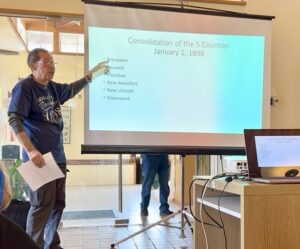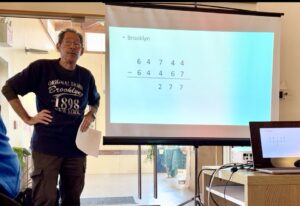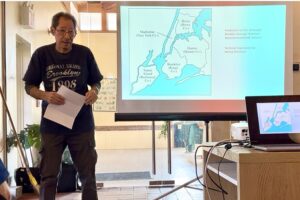Residents packed the Salt Marsh Nature Center, at 3302 Avenue U, to hear Brooklyn Borough Historian Ron Schweiger recount Brooklyn’s 1898 merger with New York City at an event sponsored by the Salt Marsh Alliance, Inc. on Sunday, November 2nd.
Schweiger, a former science teacher, has served as the Kings County historian for 23 years. He was appointed in 2002 by then Borough President Marty Markowitz, replacing John Manbeck, who held the role for nine years. Schweiger is also past president of the Society of Old Brooklynites and the Brooklyn College Alumni Association.
Through a slideshow presentation, Schweiger traced Brooklyn’s history back to the six original towns of Kings County, settled in the 1600s by the Dutch. Five original Dutch names were later anglicized: Breukelen became Brooklyn; Boswijk became Bushwick; Vlackbos became Midwout and then Flatbush; Nieuw Amersfoort became New Amersfort and then Flatlands at Kings Highway and Flatbush Avenue; Nieuw Utrecht became the Borough Park, Bay Ridge and Fort Hamilton area; and Gravesend was founded by English settlers under Dutch authority.
In 1636, the Dutch purchased land from the Canarsee Indians. In 1664, the English took over without a fight because the Dutch settlers were farmers and didn’t want to fight. Although then governor of New Amsterdam, Peter Stuyvesant, wanted to fight, he was told not to by the king of the Netherlands. By 1683, the king of England named the entire area Kings County and New Amsterdam became New York.
With many anecdotal stories, Schweiger traced Brooklyn’s development through the people who helped shape it. Key time periods included the Revolutionary War in 1776 when most of the area became English property, the transformation of the town of Breukelen into the City of Brooklyn in 1834, and Williamsburgh’s brief period as a city from 1851 to 1855, before it was annexed along with Greenpoint and Bushwick into the City of Brooklyn and had its name changed to Williamsburg.
Schweiger described the extraordinary growth of the beer industry and broader industrial expansion along the East River in the Williamsburg, Bushwick and Greenpoint area, as well as the impact of various forms of transportation, piers and the Brooklyn Bridge, which connected Brooklyn and New York City in 1883. This led to the expansion and development of Brooklyn from the burgeoning population growth in Lower Manhattan from the middle to late 1800s.
In 1890, the Greater New York Commission was established to explore the idea of consolidating the five counties into one greater City of New York, once all the towns of Kings County were incorporated into the City of Brooklyn through referendum.
This led to a men-only referendum vote in 1897 because women were not allowed to vote at that time. Manhattan and the Bronx — then considered one borough and later separated into separate boroughs in 1914 — voted in favor by a huge margin as did Queens and Staten Island. Brooklyn passed by a slim margin of only 277 votes: 64,744 in favor and 64,467 against. Opposition came mainly by farmers in southern and eastern parts of Brooklyn who wanted paved streets, a more modern sewer system and connection to the New York City water supply instead of relying on smaller, less reliable reservoirs nearby in Long Island and Queens.
According to Schweiger, thousands of Brooklynites gathered by the steps of Brooklyn City Hall on New Year’s Eve 1897 to await the stroke of midnight, when a poet named Will Colton read a poem, “The Passing of Brooklyn,” to mark the forthcoming consolidation of Brooklyn into the greater City of New York on January 1, 1898.
Schweiger quoted the last lines of the poem, ”Brooklyn it is, Brooklyn it shall be and Brooklyn are we.”
“One second after midnight, Brooklyn was Brooklyn, but it was part of the greater City of New York,” Schweiger said.






